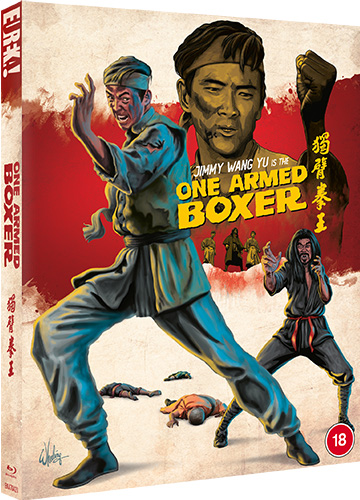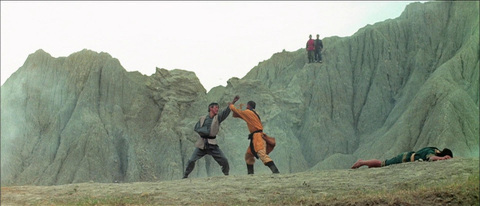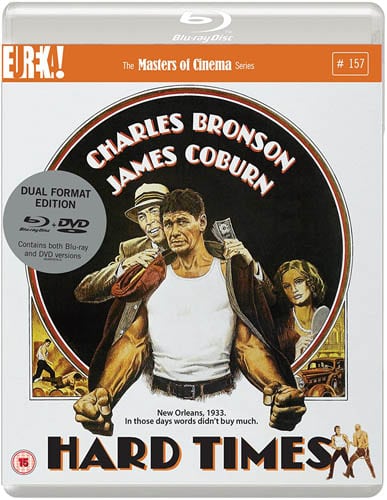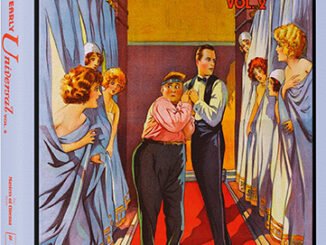One-Armed Boxer (1972)
Directed by: Jimmy Wang Yu
Written by: Jimmy Wang Yu
Starring: Fei Lung, Hsin Tang, Jimmy Wang Yu, Yeh Tien
AKA DU BEI CHUAN WANG
HONG KONG
AVAILABLE ON BLU-RAY: 24TH MAY, from EUREKA ENTERTAINMENT
RUNNING TIME: 90 mins
REVIEWED BY: Dr Lenera

Tien Lung is the best fighter at the Ching Te martial arts school. At a restaurant, he gets into a fight with members of the Hook school. Rivals of the Ching Te school, the Hook lot are also part of a local opium-dealing and prostitution ring run by a man named Chao. The latter are defeated several times, and Chao himself loses to Tien’s master, Hang Tui, so Chao hires a diverse group of mercenary martial artists from Shanghai. All members of the Ching Te school are killed except for Tien Lung who escapes minus one arm. He’s found by a woman named Jade and her father, who happens to be a specialist in medicine….

I couldn’t resist chuckling a little when I was reminded that the next screener on my list was One Armed Boxer, seeing as it’s such a contrast with the previous film I did, The Spy Who Came In The Cold. I wouldn’t be surprised if some are wondering why Eureka Entertainment are bothering with something like One Armed Boxer, even considering the previous Hong Kong movies they’ve released. But damn that attitude to hell. I think it’s fabulous that Eureka, by bringing this out, are stating that this is a film of worth, and from a genre which could do with some proper studying and appreciation. It’s basically a remake of star Jimmy Wang Yu’s earlier The Chinese Boxer mixed with elements of his The One Armed Swordsman. It has most of the expected hallmarks including a very typical plot with few narrative surprises, has some bizarre touches, and is absolutely packed with fight sequences. It may not be the most fight-filled film ever, but it’s certainly the most fight-filled film that I’ve ever seen, and manages to also wring variety on the brawls by use of fighting styles and settings. The fighting isn’t particularly fluid and the attempt at some realism jars with usage of wirework and touches of downright peculiarity, though the blood really flows. Editing is sometimes used to enhance a feeling of power in a move rather than us seeing it all in one. And let’s hear it for Wang Yu. This may be hard to believe seeing as he’s hardly a household name these days, but he was the most popular Asian martial arts star, even garnering some fame in the West especially in the United States at a time when the martial arts movie was really popular, until a certain Bruce Lee came on the scene.
Wang Yu broke out with The One Armed Swordsman, but it was The Chinese Boxer, both written and directed by him, which truly made his name. It wasn’t the first martial arts film to emphasise unarmed combat, but it was the first one to make a big impact. Both of these films were made at the legendary Shaw Brothers studios, but after a few more efforts including two sequels One Armed Swordsman and Zatoichi Meets The One Armed Swordsman, Wang Yu became unhappy with the low wages and lack of creative control he was experiencing there, so he split and joined the relatively new Golden Harvest studio which offered him a better deal. However, he was hit with several lawsuits by Shaw Brothers, effectively preventing him from working in Hong Kong, so he had to shoot his films in Taiwan including One Armed Boxer. It was shorn of several gory shots by the Hong Kong censors. It did well if not spectacularly at the box office. The American version was strangely called The Chinese Professionals. A UK cinema version was cut by nearly three minutes, losing slow motion stomach and knee blows, an arm breaking, closeups of weaponry, a two fingered blow, head kicks, and a scene where a diagram is used to show fatal pressure points on a human body. I used to have the UK video edition, and Eureka’s uncut version seemed to have more blood than I remembered, though I don’t know exactly how much was previously cut out. Wang Yu later continued the one-armed theme with One Armed Swordsman Against Nine Killers and One Armed Chivalry Against One Armed Chivalry, while it was his direct sequel to this movie entitled One Armed Boxer 2 that became more widely known under its American title Master Of The Flying Guillotine.
No time is wasted starting off both the plot and the action. Four members of the Ching Te school enter a teahouse but as soon as they’re sat down are accosted by ten or eleven others, the leader Tien Pao claiming that they’re sitting at his table. He than knocks down one of the students who’s then kicked many times while he’s on the ground. Well, no decent person who’s also an expert in the martial school should tolerate this, so Tien Lung, who’s at a nearby table, bursts into action along with his friends until Tien Pao challenges him to come to “the valley“. And then we get the main titles, full of shots from the film and probably others, all of Wang Yu, plus two little cartoon red figures fighting while a seriously cool spaghetti western-style theme is heard. A pitched battle ensures with the Ching Te school triumphant, but their victory doesn’t change Master Han Tui’s opinion that the fight was wrong. However, he says that he would have done in the restauarant what Tien Lung did, so he goes lenient on Tien Lung; just three whacks on his bum with a big stick, three days of cleaning the altar and one day of just kneeling. Tien Pao tells his master Chao that it was Tien Lung who started things. “He’s one of their best men, a clever fellow, and a troublemaker too”, remarks Chao, who leads a group to the school resulting in more fighting and Chao losing to Han Tui. But Chao won’t give up, so he hires a bunch of fighters to help him, cue for a series of one on one duels. This will probably be where some viewers may check out if they don’t absolutely love punches, kicks, jumps through walls and so forth. It may not help that Wang Yu was not a trained martial arts. He was, though, a athlete especially good at swimming, meaning that he still has agility and moves very well so can carry out decent leaps and jumps.

But the attention will often be on his opponents. The leader is Erh Ku Da Leung, a karate champion from Okinawa [despite his name] who has fangs. Favourite quote, when asked if he’s tired from his traveling: “Enduring hardship is part of my training, I never need to relax”. Then there are his disciples Kao Chiao and Shan Mao. Tibetan lamas Ko Fu and Cho Lung, one of whom can inflate so his pressure points can’t be penetrated. Mi Tsu and Ni Tsai are Muay Thai fighters from Thailand who like to do a ceremonial dance before fighting. Korean taekwondo master Chi Yung. And last but certainly not least, Mura Singh a yoga expert from India though obviously played by a Chinese guy in blackface back in the days when no one got wound up about such things – though surely they could have darkened his hands as well? His best trick is to fight upside down, running on his hands in fast motion. The first scene involving the Tibetan duo is hilarious. They are late to the party, and Erh Ku says “we do not need Tibetan priests”, but then the Tibetans crash through the ceiling and one of them says, “this is just a warning, do not underestimate Tibetan fighters”. These guys decimate the school and Erh Ku chops off one of Tien Lung’s arms with his hand. No, the moment isn’t convincing, but realistic severed limbs and heads were generally hard to pull off back then, at least for productions that didn’t have a lot of money to spend. Tien Lung flees and then the film does something rather odd. Tien Lung is taken in and revived by a man and his daughter, but this is shown by a series of stills rather than actual scenes. Either the running time was deemed to be too long so they cut some footage out, or they just did it this way because, after all, this stuff was deemed boring because it had no action in it!
We do dwell on Tien Lung’s strange variation on the training we usually get in these films. To make his only hand and arm really strong and deadly, he has to use an elixir that Jade and her unnamed father possess. But for it to work, Tien Lung must destroy all the nerves in his remaining arm, which he agrees to do so by repeatedly singing his arm on an open flame, a really grueling scene that goes on for a long time and is convincingly acted by Wang Yu in a development of a scene in The Chinese Boxer. He follows this by lowering a boulder over and over again onto his hand. Thank goodness it’s followed by some comedy when Jade sees Tien Lung and says that she’s not impressed by him chopping a pole in half, so he shows what he can really do and she’s not pleased. The main objective of Wang Yu, who don’t forget also wrote and directed, was obviously to present as much action to the viewer as he possibly could, but he knew that some relaxation and build-up were necessary before it took off again, beginning when he leaves Jade on her own in the teahouse, a stupid thing to do really. The romance is shortchanged, and that’s something we both expect and tolerate, but I wish that her dislike of his brutality, something shown in said teahouse scene, has more made out of it. It makes for an interesting continuation of an early skirmish where Erh Ku lays about people with a cudgel with distinct relish. He sometimes gets rather carried away. The film could have gone a bit deeper into this, and that’s something I would have liked. However, I think that Wang Yu knew that most people who’d go and see this film wouldn’t want such depth, so he just suggested it – which is okay I guess.
Editing is sometimes used to enhance a feeling of power in a move rather than us seeing it all in one. While we get to see his character rise up several times from the ground without the need of his arm and even briefly fly through the air, too much of Wang Yu’s armless action consists of him hitting people with his remaining arm very hard, while we can sometimes see that other arm which may cause laughter for some, but this is the thing – in the days before CGI it would have been bloody hard to totally conceal it. Wang Yu is a proficient enough director to not let it show as much as it could have done, and brings some style here and there, such as effective use of slow motion and some unusual transitions such as a zoom into somebody’s face as the screen goes white and we dissolve to writing on a white piece of paper against a white wall above an altar. I’m not at all making any claims for him to be any great shakes as a filmmaker; there are a lot of clumsy moments in this film too, but he was certainly trying, while cinematographer Mo Shen Ku gives us a few nice shots, noticeably of the final quarry setting with steam coming up out of the ground in several places. A factory provides another well used locale for fighting with people falling in vats of boiling water. The version I watched fully was, of course, the English dubbed one, though I’ll flick through both the Hong Kong tracks and comment on the differences that I notice below. The music score on the English dub is very odd. The spaghetti western main theme recurs, while other tracks seemingly chosen for their weird instrumentation and even inappropriateness prevail elsewhere. Two short snatches from John Barry’s scores to You Only Live Twice and Diamonds Are Forever turn up, joined on to credited composer Wang Fu Ling’s own, heavier music. I don’t think I’d want the score to One Armed Boxer to be any other way. In it’s own way this film is kind of awesome, something one can say now without sounding like an idiot.
Rating: 









SPECIAL FEATURES
Limited Edition O-Card slipcase featuring new artwork by Darren Wheeling [2000 copies]
Limited Edition reversible poster featuring new and original artwork [2000 copies]
1080p presentation on Blu-ray from a new restoration of the original film elements (worldwide debut of this restoration on home video)
The days of scratchy pan and scan prints with missing frames of these films are long gone. This is a strikingly impressive restoration which has some minor hue fluctuations in the first few minutes before becoming virtually flawless. The colour scheme is fairly muted, but the balance is just right, the grain is even and the detail is plentiful.
Original Mandarin and English audio options
I did check out the two Mandarin soundtracks in a few sections. The original track has a version of Isaac Hayes’s theme from Shaft over the main titles and two longer portions of John Barry’s You Only Live Twice and Diamonds Are Forever scores. The alternative Mandarin track has the same music as the English, except in a few cases where there are no music at all.
Optional English Subtitles
Brand new feature length audio commentary by Asian film expert Frank Djeng (NY Asian Film Festival)
Djeng provides a typically fine commentary which in no way looks down at the time despite pointing out two glaring plot holes which I really ought to have noticed. I couldn’t find much production information on this film, and it seems that the much more knowledgeable Djeng couldn’t either. Early parts of the film contain some small gaps with no commentary, but these gaps rapidly lessen around a third of the way through. This is still a track with lots of information about Wang Yu, identification of the fighting styles, and pointing out writing in Chinese and cultural differences. He even tells us a lovely story of how a few weeks of acupuncture cured his cerebral palsy!
Alternative English credits
Stills Gallery
Original Hong Kong trailer
‘The Chinese Professionals’ teaser
Limited Edition collector’s booklet featuring new writing by James Oliver and archival writing [2000 copies]
An absolutely essential purchase for martial arts movie fans, but it’s fair to say that others may struggle to see the appeal of its non-stop fighting. Highly Recommended with reservations.





Be the first to comment